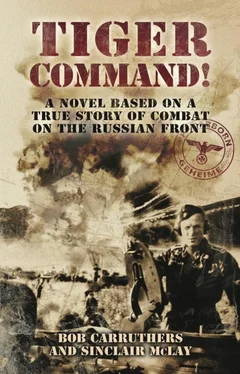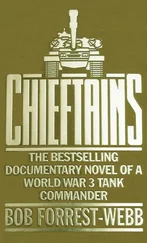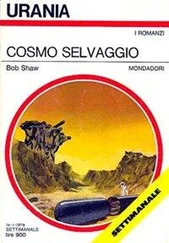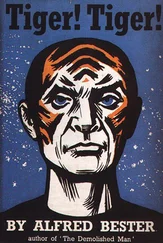As random runners appeared at the half-track command post, the situation became less and less clear. Voss therefore had no option but to issue oral and fragmentary orders to hold the main attack, as the heavy artillery was needed elsewhere and there was no longer the guarantee of the strongest possible artillery support.
Towards 11:30 am the situation took a new turn. Voss was heartened to learn that the aggressive élan of the attacking elements was able to accomplish what had not been considered possible in view of the estimated enemy situation. By exploiting the bold forward thrust of the returned assault guns, elements of the infantry and parts of the engineers had succeeded in forming an advanced bridgehead, thereby clearing the way for a sweeping manoeuvre by the cavalry, and paving the way for a general attack across the bridge by the main attack group. If reinforcements could come up soon, the whole attack was likely to be successful.
Finally, the Angriffsgruppe arrived at the bridge. Voss immediately collared the liaison officer with the attack group.
“The situation is fluid; there has been a change in the situation since the issuance of the order for a hold on the main attack. It now appears possible for the forward movement to gain sufficient momentum for a successful advance. I have countermanded my order. You must attack now and push on towards your objective.”
“Jawohl, Sturmbannführer!” barked the liaison officer, and the column roared off. Without further ado, the Angriffsgruppe swept over the bridge and into the attack. It was now imperative to prevent the attack from stalling; this was the moment to press forward with all available strength.
A considerable element of danger was recognised by Voss in the fact that, during the sweeping continuation of the assault, the attacking force might run into its own artillery fire. However, efforts to shift the fire to a box barrage succeeded in time and, falling directly in front of the panzers, it greatly facilitated the attack. The liaison officers with the attacking units were ordered and rushed forward with the new and final order to dispense with any preparation for a coordinated attack and to press on with the attack now in progress.
Frustrated by the lack of a complete picture, Voss took a decision to move his command post to the far bank. The Gefechtsstandfahrzeug roared over the bridge. Voss observed that there were one or two dead Russians lying in every foxhole. Now and then, shots were still being fired by some individual Russians who had obviously simulated death, but Voss was satisfied that the mopping-up operation was already underway.
In the far distance, it was obvious that only a few Russian light tanks were still resisting. They were disabled by the assault guns, and some of them were abandoned by their crews. The Ivans had apparently been forced to give up any intention of defending, both by the fierce attack and by the effective artillery fire. The enemy had been caught in the ferocity of the attack by the main Angriffsgruppe.
While a few enemy riflemen and heavy weapons, supported by tanks, were holding out until the last, everything else appeared to be in full flight. Enemy riflemen, approximately two companies in strength, were observed to the northwest in scattered retreat. This was apparently the enemy’s infantry reserve. The encouraging signs were that the enemy artillery left some single guns behind in their emplacements. The rest withdrew to the northeast and, caught in the pursuit fire of the medium artillery, were soon abandoned by the enemy.
Voss, flushed with the thrill of success, pushed on beyond the bridge in an effort to keep up with the changing situation. As he breasted the hill, he ordered his command half-track to halt under the spreading branches of a tall oak tree. From the back of the Gefechtsstandfahrzeug, he anxiously scanned the advancing panzers. Initially, all appeared to be going well. The tanks advanced in the textbook manner, arranged in the standard breitkeil, or “broad wedge”, when suddenly a series of violent explosions rippled through the lead tanks.
The radio burst into life. “Anti-tank gun screen!”
More and more panzers rolled to a halt. In next to no time, Voss could count twelve flaming wrecks. The attack lost momentum, and his concern rose as they began to reverse. As if from nowhere, there came the whoosh of an incoming round. Voss was knocked off his feet by the blast. As he stumbled up, his dazed brain came back to life, and his eyes focused on a terrifying sight.
Arranged between him and the bridge was a force of around 100 Soviet tanks. Before his eyes, the thin screen of German defenders and anti-tank guns screening the bridge was rolled up. He looked back in horror as another wave of Soviet armour emerged from the north. They were led by T-26 light tanks, each spouting thin bursts of flame.
He was trapped. Voss could see his infantry force fading away under the assault of the flame-throwing tanks. Burning grenadiers, reduced to human candles by the Soviet terror weapon, dotted the battlefield. He was merely a spectator as his panzers were picked off, one by one, by a large force of T-34 tanks which appeared to come from nowhere.
For a brief moment, Voss and his adjutant mentally prepared to fight to the death, but the simple truth was that the situation was so obviously hopeless that the will to commit suicide evaporated. As a KV-1 with the stencilled outline of a White Devil hurtled towards them and pulled up beside the Gefechtsstandfahrzeug, Voss and his small command group left the vehicle and raised their hands in surrender.
The commander of the Russian tank climbed out and stepped down. As his feet hit the ground, he was joined by four T-34 tanks, each bearing a full complement of desyanti. The tank riders, too, dismounted, and formed a circle around the five German prisoners, binding their hands behind their backs.
“SS-Sturmbannführer Helmut Voss, if I am not very much mistaken…” began the Soviet tank commander in perfect accentless German.
“That is correct,” replied Voss, offering the absolute minimum of information, but apprehensive as to why it was necessary to tie their hands behind their backs. “I demand that my men are properly treated.”
“Don’t worry, they will be…” said the tank commander, removing his cap and wiping the sweat from his brow. His thick black eyebrows contrasted with the bushy shock of pure white hair.
“Stenner!” gasped Voss.
Voss said no more as the Soviet commander flashed a dagger across his throat, severing his vocal chords and his windpipe. On Korsak’s signal, a member of the tank crew stepped forward with five rope nooses and began to loop them over the bough of the oak tree. With no ceremony, the cords were fastened around the necks of the German prisoners. One by one, the prisoners were strung up and left to die like dogs.
From the ranks of the curious Soviet spectators, an official photographer was on hand to record the gruesome sight. Korsak made sure that he took a good shot which featured the KV-1 with its White Devil motif prominently displayed in the foreground and the dangling bodies behind. Justice was being visited on the fascist beasts and Korsak was anxious to make sure Moscow knew that the Weisse Teufel had been at work.
*
The news of the ignominious death of SS-Sturmbannführer Voss struck home hard, but there was nothing that could be done at Paderborn. Until the new tank was combat ready, von Schroif and his crew had little option but to work hard and push the machine through its paces in readiness for what was projected to be a combat debut in 1943.
Throughout July, the testing programme continued. Other tanks emerged from the factory and other crews appeared to take charge and begin the complex task of learning how to maintain and operate the Tiger. As the nights slowly became longer, the senses sharper, the bonds tighter, von Schroif estimated that by April 1943 the Tiger would be ready to be tested in combat. It was frustrating to have to wait so long, but the machine was still a prototype.
Читать дальше












